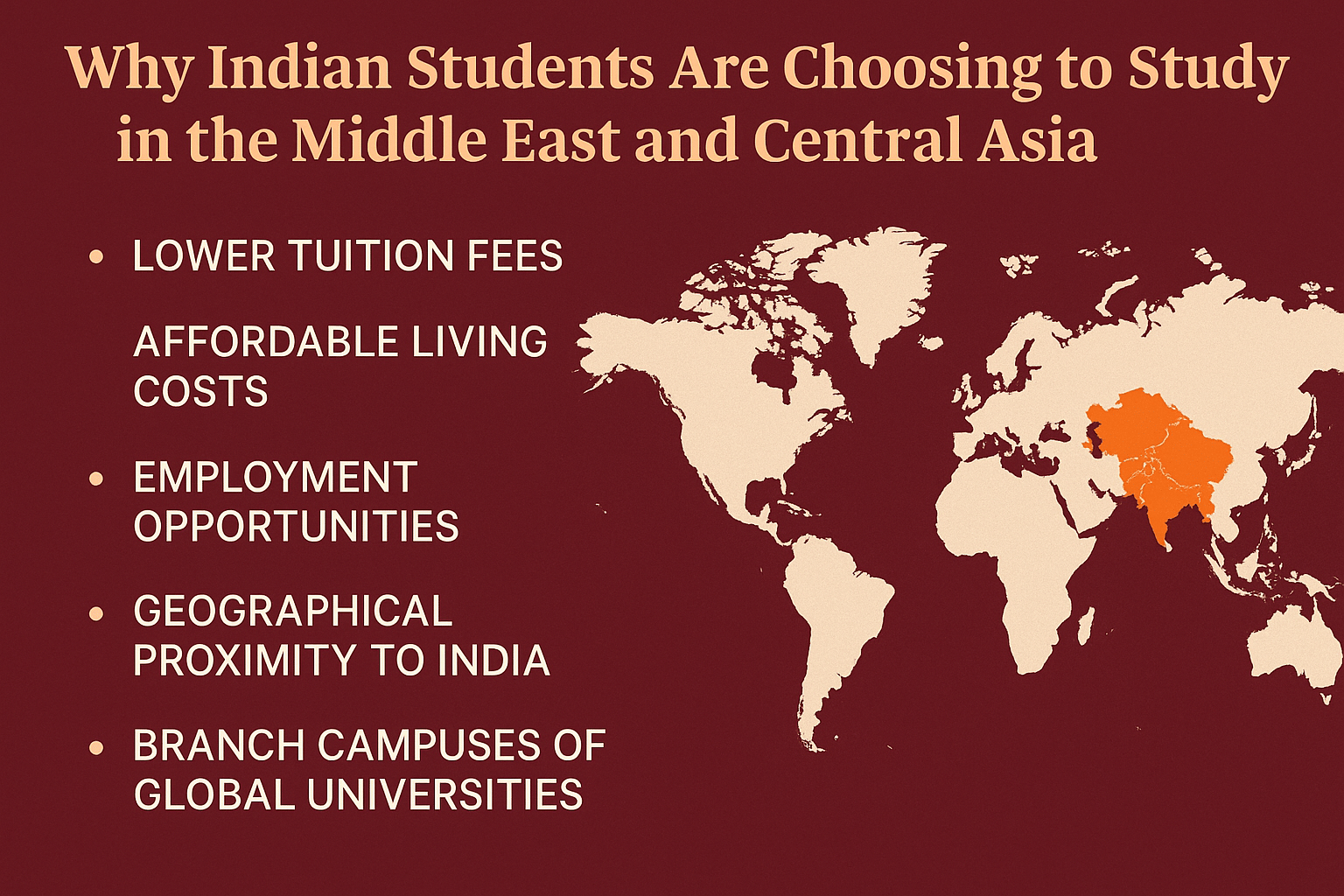Jasmine Grover Study Abroad Expert
Study Abroad Expert | Updated On - Oct 1, 2025
In 2025, over 1.8 million Indian students are expected to study overseas. Traditionally, most opted for the US, UK, Canada, and Australia, but the cost of living, stricter visa rules, and intense competition are changing preferences. Now, a growing number of Indian students are setting their sights on Middle Eastern and Central Asian destinations like the United Arab Emirates (UAE), Saudi Arabia, Turkey, Russia, Uzbekistan, and Kazakhstan.
These countries are positioning themselves as affordable yet globally connected education hubs, making them attractive for Indian families who want quality education without the financial burden of Western universities.

Also Read
Why Middle East & Central Asia Are Gaining Ground?
1. Affordable Education
- Tuition fees in Kazakhstan, Uzbekistan, and Russia are far lower compared to the West.
- MBBS and STEM courses in Kazakhstan cost 70–80% less than in the UK or US.
- Russia remains a top choice for medical education, with nearly 31,000 Indian students enrolled in 2024.
Check Out: MBBS in Russia
2. Lower Living Costs
- Cities like Almaty, Tashkent, and Ankara offer significantly cheaper living than London, Toronto, or Sydney.
- Students can manage accommodation, food, and travel at half the cost of Western destinations.
3. Proximity to India
- The UAE and Saudi Arabia are just a few hours by flight, making it convenient for students and parents.
- Quick travel means less homesickness and easier cultural adjustment for students studying in UAE.
4. English-Taught Programs
- Many universities in Turkey, Russia, and Saudi Arabia now offer courses in English, attracting students who don’t speak local languages.
- Branch campuses of global universities (like New York University and Sorbonne in Dubai) allow students to earn internationally recognized degrees at lower costs.
5. Work Opportunities While Studying
- Countries like the UAE, Saudi Arabia, and Turkey allow part-time jobs for international students.
- Growing industries and multinational companies in these regions provide internships and work experience during studies.
Case Study: Enrollment Boom
- Kazakhstan: Indian enrollment grew from 3,855 in 2022 to 12,020 in 2025.
- Russia: Hosts more than 31,000 Indian students, with MBBS and engineering as the top choices.
- Dubai: Over 42,000 international students are currently studying there, many of them Indian.
Comparison: Traditional vs. Emerging Destinations
| Factor | US/UK/Canada/Australia | UAE / Russia / Kazakhstan / Turkey |
|---|---|---|
| Tuition Fees | High (₹25–50 lakh per year) | Affordable (₹4–12 lakh per year) |
| Living Costs | Very expensive | Moderate to low |
| Scholarships | Available, but competitive | Growing, but limited |
| Distance from India | Long flights, expensive travel | Shorter, cheaper flights |
| Language of Study | English | English increasingly available |
| Work Opportunities | Good, but strict visa rules | Easier part-time work options |
| Cultural Familiarity | Low to moderate | High (especially Middle East) |
Why Indian Students Are Reconsidering Their Choices?
For many Indian families, the shift isn’t only about cost. It’s about balancing quality education with career security.
- The US H-1B visa fee hike and stricter immigration rules have made American education riskier.
- The UK and Canada are tightening post-study work visas.
- In contrast, the UAE, Russia, and Kazakhstan are actively recruiting international students and offering smoother visa processes.
The study abroad trend of 2025 shows a rebalancing of priorities. Indian students are moving from chasing only “prestige destinations” to seeking value-driven options. With affordable tuition, easier access, and growing job markets, the Middle East and Central Asia are no longer backup choices—they’re becoming frontline study abroad destinations.
For Indian students planning their next step, this is the moment to look beyond the West and explore opportunities in regions that are rolling out the red carpet for global talent.









Comments